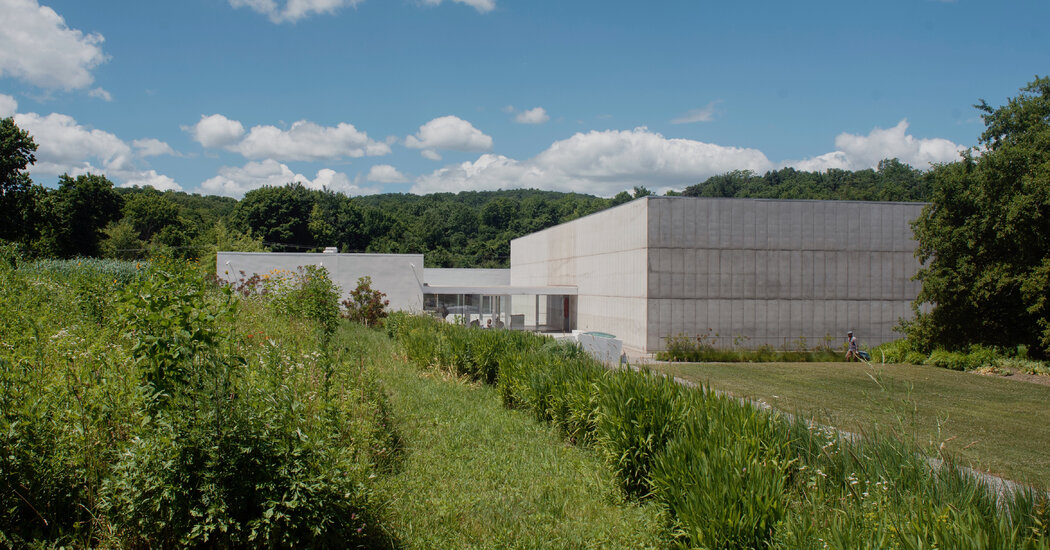
Back in 1967, Arte Povera artists in Italy, the radicals of their time, hung out at the Piper Club, a discothèque of, by and for the avant-garde in Turin. During one nocturnal happening, young women danced in tunics made of polyurethane birch logs and ponchos studded with foam rocks to look like riverbeds. Like nature sprites, the dancers gamboled over “nature carpets,” rugs crafted of foam by the Turinese artist Piero Gilardi. Guests sipped their Camparis reclining on simulated cabbage patches.
In the radical cheek of a disco decked out as a forest glade, Gilardi delivered a serious message, embodying the ecological lesson of Rachel Carson’s “Silent Spring” written a few years before: Chemicals were poisoning the earth. Nature starts in the home. Live with it, respect it, protect it.
Now, some 55 years later, in the show “Gilardi: Tappeto-Natura” at the Magazzino Italian Art museum in Cold Spring, N.Y., two long-legged mannequins dressed in the same tunics surveil more than a half century of Gilardi’s nature carpets, as though looking at a farmers’ market of produce during a summer of watermelon.
Magazzino carries over the same environmental message to another institution just down the road in Garrison, Manitoga/The Russel Wright Design Center, an architectural version of Gilardi’s nature carpets. Magazzino introduced the Milanese design firm Formafantasma to what is basically a modernist treehouse, where its two principals, Andrea Trimarchi and Simone Farresin, refreshed the timber structure with a subtle placement of its own organic product designs throughout the organic building.
In hindsight, given today’s environmental crisis, Gilardi’s nature carpets and Russel Wright’s timber structure, both dating from the 1960s, stand as historically prescient examples of art with an environmental message — though Gilardi and Wright sounded the same alarm through differing artistic expression: iconoclastic, contemporary sass versus Walden Pond.
At Magazzino, Gilardi carved a rough-hewed Technicolor landscape of fruits and vegetables from the most synthetic industrial materials, polyurethane painted with synthetic pigment. On thick contoured foam beds, he glued sea urchins, pumpkins, corn cobs, grapes, even the occasional armadillo passing through. The “furniture” allowed families to live with the idea of the outdoors in their living rooms, reconnecting life in the city to an increasingly fragile and defensive nature. He was introducing nature into the over-industrialized world that was killing it.
Gilardi, now 79 and living in Turin, was intellectually peripatetic, dropping in and out of the art world, pursuing ideas from ecology to digital technology to community-based art. But over a 60-year career, the backbone of his production remained nature carpets, a genre to which he returned in almost every decade, always with an ecological message delivered with puckish delight: vividly colored, slightly cartoonish, sometimes over-the-top pieces that eschewed the controlling hand of a master. He was a Geppetto, an anti-Michelangelo carving a cheap material incapable of the refinement of a masterwork. He seemed to mock the object as he made it.
In 1966, Gilardi already dreamed of reuniting all the carpets in a single space, an idea that the curator Elena Re honored at Magazzino. The nature carpets form a small field, each tile in this artificial but cornucopian paradise charming in its own microcosmic way, some alive with fluorescent greens, some topped with sea gulls planing over patches of ocean. One carpet is attached to the wall on a spindle, as if to say that the carpets are not precious, but sold off the rack by the yard.
In Italy, the nascent environmental movement was one of many forces breaking the country’s long tradition of classical masterpieces that seemed to block art’s entry into contemporary life. Throughout Western Europe and the United States, a new era was calving off an older one. Students rose against consumerism. TV swallowed lives. A decade of social turbulence proved especially violent in Italy, with bloody demonstrations and weekly kidnappings.
Radicalized artists and designers pivoted from Italy’s legendary artistic and architectural past to create a future that spoke to the changing times. Gilardi duck-and-draked through the art world, evading success, fame and signature as he migrated through a succession of interests, reinventing himself then disappearing. He traveled widely outside Italy, including to New York, to understand art’s fast-changing panorama. To maintain his artistic autonomy early in his career, Gilardi rejected the gallery system, severing ties with several galleries, including the Sonnabend in Paris. Back home in Turin, he embedded with workers and activists in collaborative art projects aimed at engaging communities. Democratic art had to be accessible, and artists had to stay free.
Gilardi became an early member of the Arte Povera (“poor art”) group, anti-formalist artists who produced anti-masterpieces by using everyday materials, often put together casually: Concept rather than beauty mattered. American land artists left the gallery system to work in the landscape. Gilardi brought the landscape inside.
Open since 2017, Magazzino has been a landing strip in the United States for Arte Povera and other postwar and contemporary Italian work. Gilardi’s carpets culminate a suite of Magazzino’s top-lit galleries containing Arte Povera classics, all of them displaying attitude more than form. The galleries loop around a courtyard in a former farm warehouse — magazzino means warehouse in Italian — repurposed as a museum in a white, minimalist style by Spanish architect Miguel Quismondo.
With luminous interiors, the pristine but unpretentious building is a subtle container for its subversive and challenging art, and a geometric foil to the surrounding landscape, which itself embodies lessons suggested by Gilardi’s micro-ecosystems. Meadows bordered by native plants give way to an orchard and a protected wetlands beyond. Sculpture is embedded episodically in the lawns. A corral of 16 donkeys just up the hill suggests the museum’s rural affinity. Black bears occasionally scope out the scene from the hillside. A new monumental wing is now being built, designed by the noted Madrid minimalist Alberto Campo Baeza, working with Quismondo.
Magazzino has cultivated relationships with other institutions in the Hudson Valley, including Manitoga/The Russel Wright Design Center, a house famously built into a ledge of rocks overlooking a fresh water pool that was once a quarry. The Wright Center, in collaboration with Magazzino, invited Formafantasma’s Trimarchi and Farresin to comment on the house with their own contemporary product designs.
Like Gilardi’s carpets, Wright’s design, an implosion of nature built into a hillside from 1958 to 1961, was ecologically prescient, with its sod roof and interior columns made from tree trunks culled from the surrounding woods. In its rapport with nature, his design perhaps outdoes even Frank Lloyd Wright’s Fallingwater (no relation), and takes its place among the great early Modernist houses, including the Farnsworth house outside Chicago, and the Eames, Stahl, and Schindler houses, all in Los Angeles.
Wright crafted his house to saturation with handmade details, floating butterflies, for example, in acrylic door panels, as though they were flying in amber. Wright was an industrial designer, most famous for the American Modern tableware series, but he spent years perfecting a house that, reflecting Japanese inspiration, lives in nature rather than looking at it: The house disappears into the woods that engulf it. Still, he judiciously wove acrylic and fiberglass with natural materials. Like Vivaldi, Wright composed for the seasons, designing panels and fabrics to be changed in the fall and spring. He tuned and played the house like an instrument.
In the current show, Formafantasma — the exhibition designer for the central pavilion and Arsenale at this year’s Venice Biennale — seamlessly fitted their contemporary pieces into the interiors. From lighting in its Delta collection, a discrete sconce of two moon-like discs, one reflective and the other in eclipse, illuminates the entry. Recycling animal parts, Formafantasma designed glass carafes plugged with stoppers made from cow vertebrae. A chandelier over the dining table made from resin-coated cow bladders cascades through a double-height space next to a cliff of Cyclopean rocks.
Organic design doesn’t date: the original interior and the new pieces blend.
The bedrooms over the living room have been converted into a gallery of Wright’s domestic designs, specimens selected by the veteran New York curator Donald Albrecht, and exhibited in clean, curving vitrines of blond woods by the New York architect Wendy Evans Joseph.
The main house opens to a trail that climbs to the nearby guest room and studio, where Wright invented every detail. Windows surrounding the studio drop out of sight into waist-high perimeter walls, turning the room into an open-air pavilion. The studio opens onto a moon terrace, which in turn leads to trails that loop through the surrounding wilderness, 75 acres of an estate entirely owned by nature.
Wright and his wife, Mary Small Einstein Wright, named the estate Manitoga after the Algonquin word meaning “place of great spirit.” The house, inside and out, seems like a momentary pause in the landscape, a place to stop within the spirit of things, a carpet of nature in nature.
Gilardi: Tappeto-Natura
Through Jan. 9 at Magazzino Italian Art Museum, 2700 Route 9, Cold Spring, N.Y.; 845-666 7202, magazzino.art. Advance reservations are requested.
Formafantasma at Manitoga’s Dragon Rock: Designing Nature
Manitoga/The Russel Wright Design Center, 584 Route 9D, Garrison, N.Y.; 845-424-3812; visitmanitoga.org. Advance reservations are required for access to the House, Studio and Inner Quarry Landscape.




